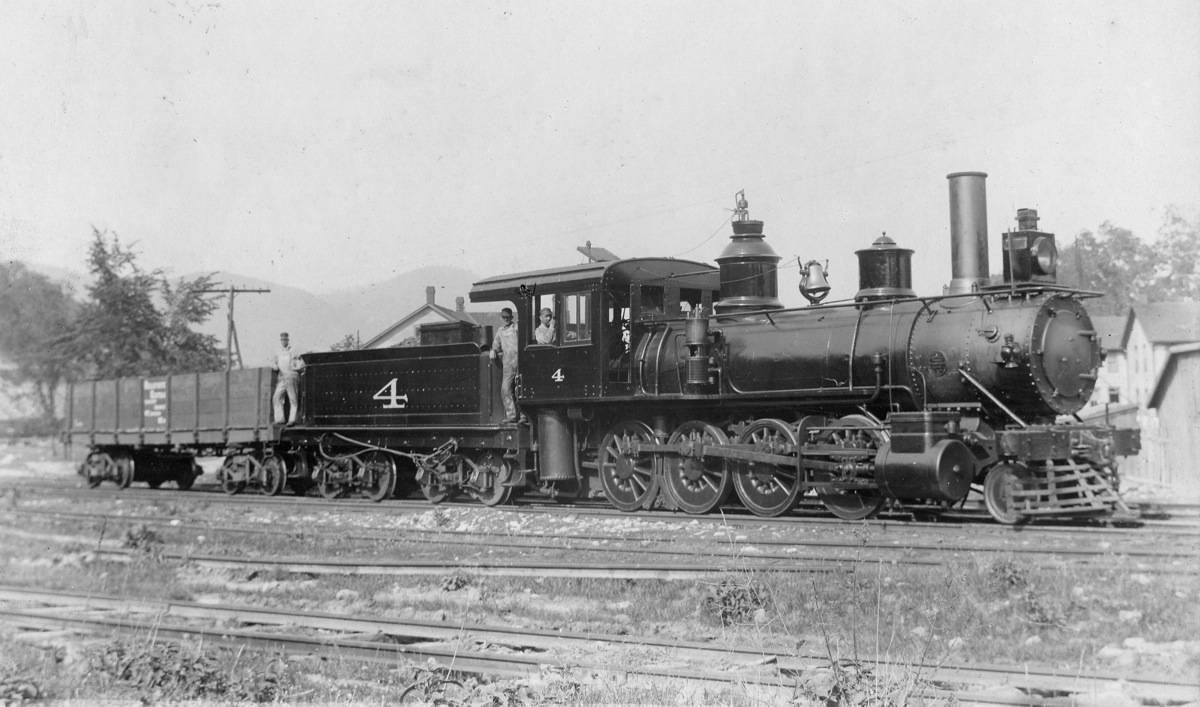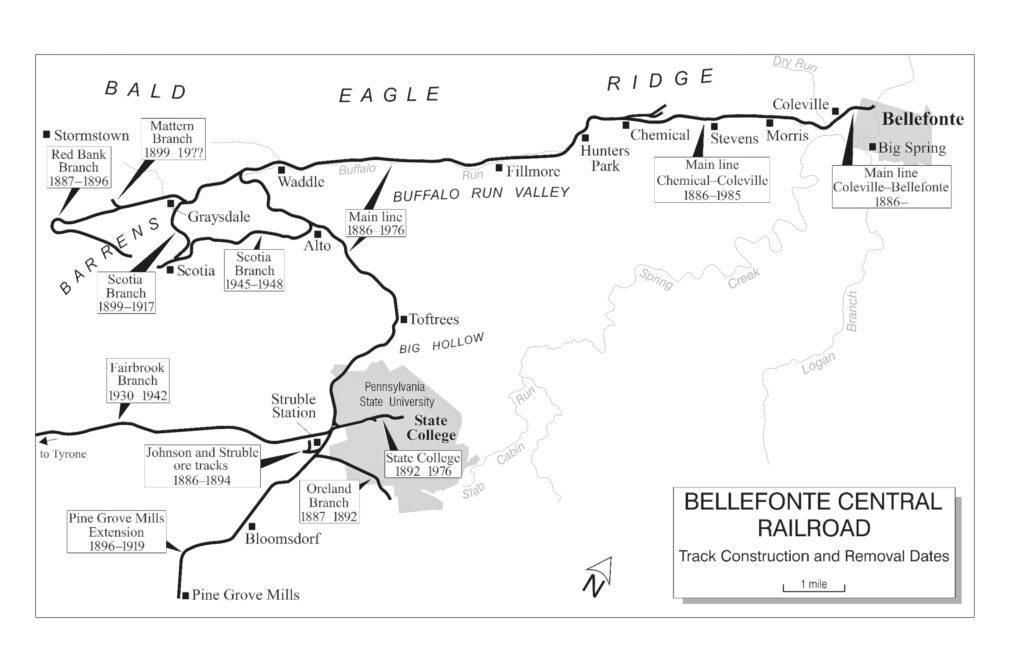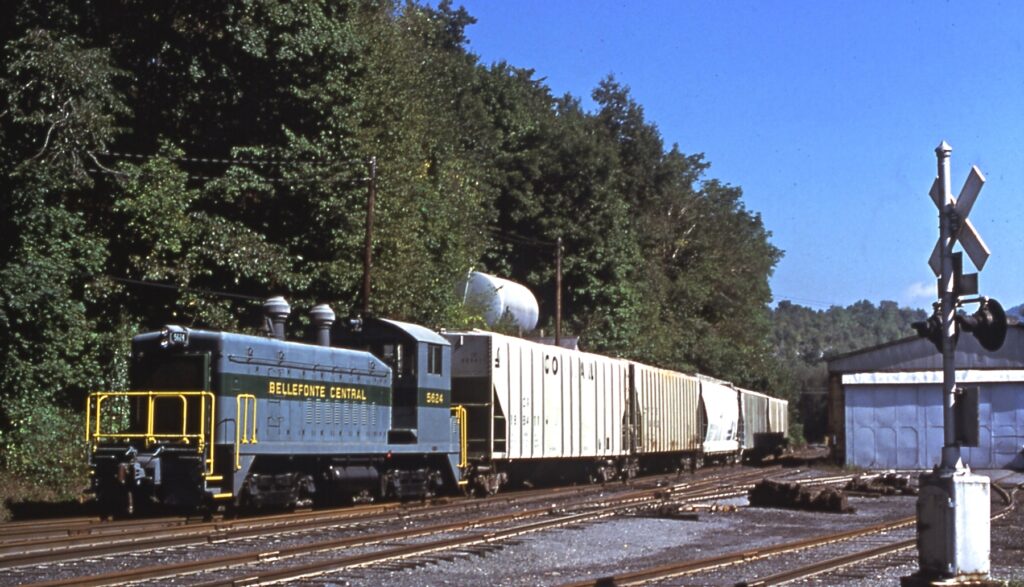During its ninety-year lifespan, the Bellefonte Central Railroad hauled nearly 16 million tons of Centre County limestone and lime to connecting railroads for distribution to industrial customers in a dozen states. For more than five decades, the railroad also made daily passenger round trips to State College, providing an important transportation link for the growing college town.
Incorporated in 1892, the Bellefonte Central succeeded the Buffalo Run, Bellefonte, and Bald Eagle Railroad, organized by brothers Philip and Thomas Collins to haul iron ore from deposits northwest of State College to Bellefonte Furnace. Philip Collins was a principal in the furnace company, which supplied pig iron to the wrought iron and steel industries. The furnace went into blast in 1888 only to shut down three years later amid a nationwide glut of pig iron.
Ownership of the bankrupt Buffalo Run, Bellefonte, and Bald Eagle Railroad passed to the railroad’s bondholders — a small group of Philadelphia investors — who reorganized it as the Bellefonte Central. A corporate office was maintained in Philadelphia and a general manager’s office in Bellefonte. An engine house and shop were located at Coleville in Spring Township.
The new company extended its lines to the campus of the Pennsylvania State College and to Pine Grove Mills, thus securing enough freight traffic to keep the railroad solvent until a surging steel industry revived Bellefonte Furnace in 1899. Soon after, steel makers began sourcing their ore from the Lake Superior region and operating their own blast furnaces.

Bellefonte Furnace closed permanently in 1910. By then the Bellefonte Central was hauling more than 100,000 tons of limestone and lime annually. As America industrialized, immense quantities of limestone and lime were required for the manufacture of iron and steel, paper, glass, chemicals, leather, and many other products. The railroad’s primary shipper was the Chemical Lime Company, which had quarries and lime plants at two locations along Buffalo Run, only a few miles from Coleville.
In 1937, Chemical opened Plant 3 nearby. It featured a deep mine and the nation’s longest rotary kiln (400 feet). Opening the new plant burdened Chemical with so much debt that in 1940 it was taken over by the National Gypsum Company of Buffalo, New York. The new owner closed the two older plants and expanded Plant 3, driving the mine 1,100 feet into the base of Bald Eagle Ridge and adding two more kilns. The limestone mined at the “Gyp” and elsewhere around Bellefonte was part of the Valentine Formation, a deposit containing an exceptionally high concentration of calcium carbonate, which meant that relatively few impurities had to be driven off during the lime-making process.
Meanwhile in 1929, the Bellefonte Central acquired an 18-mile line from the Pennsylvania Railroad that ran from Fairbrook via Warriors Mark to near Tyrone. It then built a 5-mile connection between Fairbrook and State College. Attempts to attract new freight customers along the “Fairbrook Branch” fizzled with the onset of the Great Depression, and the Bellefonte Central ceased using the line in 1933.

Countering that disappointment was new business around State College. Penn State’s enrollment grew steadily, resulting in more construction on campus and around town. Nearly all building materials, interior furnishings, and other products came in by train. In some years, State College-bound traffic accounted for about 20 percent of the Bellefonte Central’s gross income.
After World War II, the entire railroad industry was adversely affected as trucks made steady gains in capturing freight that previously rode the rails. Carloads terminated at State College declined from about 1,300 in 1950 to barely 500 in 1960 to 189 in 1970. The downward slide proved unstoppable. The Bellefonte Central ended freight service to State College in 1974, leaving National Gypsum as its sole customer.
Passenger service had ended long before then. For the railroad’s first twenty-five years, carrying people was an important part of its business. Its three daily State College round trips provided that community with convenient connections to Pennsylvania Railroad trains at Bellefonte.
In addition, the Bellefonte Central established Hunter’s Park, a picnic and outdoor recreation site along Buffalo Run. The railroad operated weekend shuttles to the park from State College and Bellefonte during the warm season. In the early 1900s, the company’s annual passenger count often exceeded 60,000. With the arrival of automobiles, buses, and an emerging system of paved highways, ridership fell by two-thirds between 1914 and 1917.
In the latter year, service to State College was reduced to a single mixed passenger and freight train; Hunter’s Park service eased altogether. Ridership continued to tumble until the Bellefonte Central averaged fewer than one hundred riders annually by the 1930s. It officially exited the scheduled passenger business in 1946.

In subsequent years, the Pennsylvania Railroad operated several special trains over Bellefonte Central rails. The most celebrated occurred in 1953, when President and Mrs. Dwight Eisenhower journeyed from Washington, DC to State College by train at the invitation of brother Milton Eisenhower, then Penn State’s president. Excursions brought fans to home Penn State football games in 1955 and again in 1964 from the University of Pittsburgh, and in 1961 from the U.S. Military Academy at West Point.
Trucks eventually devastated the railroad’s core business of limestone and lime. Rubber-tired competition, combined with poor service given by the Pennsylvania Railroad and its successor Penn Central, led to a decline from 204,000 tons carried in 1960 to 112,000 in 1972.
San Francisco-based Kyle Railways, an operator of short lines in several states, acquired the Bellefonte Central in 1975 but failed to reverse the downward trend. In 1982, a national economic recession led to an indefinite shut down of the Gyp, then owned by Canada-based Domtar. Absent its only shipper, the Bellefonte Central operated its last train on June 30 of that year. Over the next few years, most of the railroad’s assets were sold or transferred to other Kyle railroads.
The Bellefonte Central had secured much of its right of way by means of easements rather than outright purchase, with the proviso that should the right of way cease being used as a railroad, it would revert to adjacent landowners. Most landowners initially expressed little enthusiasm for repurposing the railroad line as a hiking and biking trail. But as popular enthusiasm for rails-to-trails ventures burgeoned statewide, Penn State and local municipalities revisited the idea.
Eventually a 1.3-mile segment of improved rail trail was constructed, starting near the end of McKee Street in State College and extending eastward, passing through the newly established Arboretum at Penn State. Several miles of largely unimproved rail trail extended beyond to Toftrees. Additional extensions, including one beginning at the Bellefonte end and working west, remain under consideration.
Michael Bezilla
Sources:
Bezilla, Michael and Jack Rudnicki. Rails to Penn State: The Story of the Bellefonte Central. Mechanicsburg, Pa.: Stackpole Books, 2007.
Simpson, Paul D. “The Bellefonte Central Railroad,” Railway and Locomotive Historical Society Bulletin, October 1967, pp. 7-17.
First Published: May 20, 2021
Last Modified: February 26, 2025
